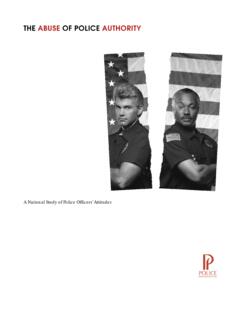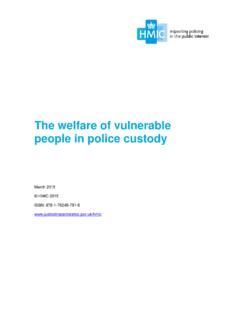Transcription of Public Trust and Law Enforcement—A Discussion for …
1 Public Trust and Law Enforcement A Discussion for Policymakers Updated July 13, 2020 Congressional Research Service R43904 Congressional Research Service SUMMARY Public Trust and Law Enforcement A Discussion for Policymakers Several high-profile incidents where there have been complaints of the use of excessive force against individuals and subsequent backlash in the form of civil unrest have generated interest in what role Congress could play in facilitating efforts to build Trust between the police and the people they serve. This report provides an overview of the federal government s role in local police -community relations. According to polling conducted by Gallup, Public confidence in the police declined in 2014 and 2015 after several high-profile incidents in which men of color were killed during confrontations with the police . Confidence in the police rebounded back to the historical average in 2017 before declining again in 2018 and 2019.
2 (Gallup data are not yet available for 2020). However, certain groups, such as people of color, people age 34 or younger, and individuals who identify as liberal say they have less confidence in the police than whites, people over the age of 35, and people with conservative political leanings. Some observers believe that a decline in Public Trust of the police is at least partially attributable to state and local police policies and practices. Federalism limits the amount of influence Congress can have over state and local law enforcement policy. General policing powers are the purview of states, but Congress can try to influence state and local policing policies by attaching conditions to grant funds. The federal government might also choose to address issues related to police -community relations and accountability through (1) federal efforts to collect and disseminate data on the use of force by police , (2) statutes that allow the federal government to investigate instances of alleged police misconduct , and (3) the influence the Department of Justice (DOJ) has on state and local policing through its role as a Public interest law enforcer, policy leader, and convener of representatives from law enforcement agencies and local communities to discuss policing issues.
3 There are several options policymakers might consider should they choose to play a role in facilitating better police -community relations, including the following: placing conditions on federal funding to encourage law enforcement agencies to adopt policies that promote better community relations; promoting efforts to collect data on the use of force by law enforcement, including evaluating potential overlap between DOJ programs that currently collect the data; providing grants to law enforcement agencies so they can purchase body-worn cameras for their officers; taking steps to facilitate investigations and prosecutions of excessive force by amending 18 Section 242 to reduce the mens rea standard in federal prosecution, enhance DOJ civil enforcement under 34 Section 12601, or place conditions on federal funds to promote the use of special prosecutors at the state level; funding Community Oriented Policing Services (COPS) grants so law enforcement agencies can hire more officers to engage in community policing activities; and using the influence of congressional authority to affect the direction of national criminal justice policy.
4 R43904 July 13, 2020 Nathan James, Coordinator Analyst in Crime Policy Kristin Finklea Specialist in Domestic Security Whitney K. Novak Legislative Attorney Joanna R. Lampe Legislative Attorney April J. Anderson Legislative Attorney Kavya Sekar Analyst in Health Policy Public Trust and Law Enforcement A Discussion for Policymakers Congressional Research Service Contents Public Perception of the police .. 1 Federalism and Congressional Influence over State and Local Law Enforcement Policy .. 3 Overview of Federalism .. 3 Spending Power and Regulating Law Enforcement Activities .. 4 Section 5 of the Fourteenth Amendment and Regulating Law Enforcement Activities .. 5 Federal Efforts to Collect Data on Law Enforcement Officers Use of 8 The Federal Bureau of Investigation s Use of Force Data Collection .. 8 Death in Custody Reporting 9 Contacts between the police and the Public .
5 12 Data from the Centers for Disease Control and Prevention .. 12 Authority for DOJ to Investigate Law Enforcement misconduct .. 14 What Roles Can the Department of Justice Play in Improving police -Community Relations? .. 18 DOJ as Policy Leader .. 18 DOJ as Law Enforcer .. 20 DOJ as 21 Policy Options for Congress .. 22 Conditions on Federal Funding .. 23 Data on police Use of Force .. 24 Promoting the Use of Body-Worn Cameras .. 25 Facilitating the Investigation and Prosecution of Excessive Force .. 27 Promoting Community Policing .. 28 Non-legislative 31 Figures Figure 1. Overall Confidence in the police , 1993-2019 .. 2 Tables Table 1. Confidence in the police , by Demographic Group, 2 Contacts Author Information .. 32 Public Trust and Law Enforcement A Discussion for Policymakers Congressional Research Service 1 everal high-profile incidents where police officers have been involved in the deaths of individuals have reinvigorated a Discussion about how the police use force against minorities and the tension that exists between police officers1 and minority communities.
6 The national debate about how police use force and police -community relations might generate interest among policymakers about what role Congress could play in facilitating efforts to build Trust between the police and the people they serve, as well as police accountability for any excessive use of force. The report starts with an overview of data on Public opinion of the police . It then provides a brief Discussion of federalism and why Congress does not have the authority to directly change state and local law enforcement practices. Next, the report reviews federal efforts to collect data on law enforcement agencies use of force and federal authority to investigate instances of police misconduct . This is followed by a review of what role DOJ might be able to play in facilitating improvements in police -community relations or making changes in state and local law enforcement agencies policies. The report concludes with policy options for Congress to consider should policymakers decide to exert some influence on state and local law enforcement agencies policy.
7 The Parameters of This Report This report provides a brief overview of police -community relations and how policymakers might be able to promote improved relationships between the police and their constituents, especially people of color. The report focuses solely on the relationship between the police and the communities they serve. It does not include a Discussion of the level of Trust in or perceived bias by other parts of the criminal justice system ( , the grand jury system, prosecutions, or corrections). The report also focuses on issues related to state and local law enforcement agencies and not federal law enforcement agencies. It focuses on state and local law enforcement agencies because congressional interest in law enforcement reform has largely centered on what role Congress might play in promoting a better relationships between state and local law enforcement agencies and their communities and how Congress could promote more accountability for state and local law enforcement officers use of excessive force.
8 Public Perception of the police Gallup, whose polling tracks confidence in a variety of institutions, found that 53% of Americans said they had a great deal or quite a lot of confidence in the police in 2019 (see Figure 1).2 Only the military (73%) and small business (68%) had greater percentages of respondents voicing confidence in the respective institutions than the police in 1 P olice depart ment s and police officers are a subset of all law enforcement agencies, which include sheriff s offices, st at e law enforcement agencies ( , st at e t roopers), and special-jurisdict ion law enforcement agencies ( , t ransit police or universit y police depart ment s). However, police and law enforcem ent agencies will be used int erchangeably in t his report . 2 Polling dat a from 2019 is the most recent available. Justin McCarthy, Confidence in Organized Religion Remains Low, Gallup, July 8, 2019.
9 Full dat a are linked in t he art icle at ht t 3 Ibid. S Public Trust and Law Enforcement A Discussion for Policymakers Congressional Research Service 2 Figure 1. Overall Confidence in the police , 1993-2019 Percentage who report a great deal or quite a lot of confidence in the police Source: Justin McCarthy, Confidence in Organized Religion Remains Low, Gallup, July 8, 2019. Full data are linked in the article at Notes: Data markers in the figure indicate points at which the reported confidence levels switch directions. Confidence in the police varies by race, gender, political ideology/party affiliation, age, and education level (see Table 1). For example, whites were more likely to say that they have a great deal or quite a lot of confidence in the police than non-whites. Variability in confidence is also evidenced among people who identify as conservative, moderate, or liberal.
10 Conservatives are more likely than liberals and moderates to have confidence in the police . In addition, a smaller proportion of people ages 18-34 said they were confident in the police compared to people ages 35-54 and people 55 and older, with the 55 and older group having the greatest proportion of people saying that they had a great deal or quite a lot of confidence in the police . Table 1. Confidence in the police , by Demographic Group, 2019 Percentage who report a great deal or quite a lot of confidence in the police Demographic Group Race White 59% Non-white 40% Gender Male 56% Female 49% Political Ideology Liberal 33% Moderate 46% Conservative 75% Public Trust and Law Enforcement A Discussion for Policymakers Congressional Research Service 3 Demographic Group Age 18-34 39% 35-54 53% 55 or older 63% Education High school grad or less 48% Some college 54% College grad 55% Source: CRS presentation of data from Justin McCarthy, Confidence in Organized Religion Remains Low, Gallup, July 8, 2019.



















